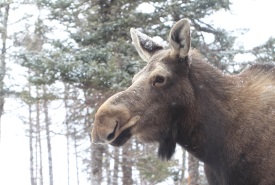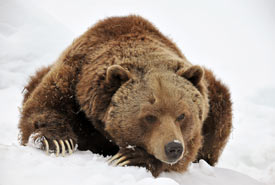Real animals don't wear scarves in winter
Of all the enticingly cute plush toys currently in store displays, the owl is one of my favourites. But the way marketers portray animals with toques and scarves throughout the winter make me cringe…slightly. Perhaps that’s because we all know real animals are prepped for the season in their own way.
How so? Here are three of Canada’s iconic species with unique winter adaptation strategies to survive in the land of ice and snow, without toques and scarves!
Padded paws – Canada lynx
The Canada lynx is one of Canada’s big cats. The main distinction from the bobcat is the lynx’s thick grey fur, longer ear tufts and black-tipped tail. Despite their size, with males weighing up to 17 kilograms, Canada lynxes have no problem trekking on deep snow thanks to their large furred paws that act like snowshoes. This feature makes them well adapted for stalking and ambushing prey (like the snowshoe hare).

Moose (Photo by Mike Dembeck)
Grow a coat, and more – the moose
The majestic moose (which comes from the Algonquian “moosh,” meaning stripper and eater of bark) is the largest member of the deer family. Several key adaptations help to keep the 450-kilogram (on average) vegetarian comfy throughout winter. Both sexes are outfitted with a thick coat of hollow guard hairs that provides insulation and is water resistant. Their cloven hooves also keep them from sinking in deep snow and soft mud. In the winter, male moose also shed those massive antlers to conserve energy and nutrients.

Grizzly bear (Photo by Caroline Henri)
Sleep it out – grizzly bear
When food is scarce and weather is frightful, perhaps inactivity rather than activity is the way to go. For the grizzly bear, one of the strongest and most impressive mammals in North America, winter is a time of dormancy. To prepare for the season, grizzlies fill up their energy reserves by eating an omnivorous (meat and plant-based) diet. They dig their dens with their powerful muscles and sharp claws. Contrary to common belief, grizzlies are not true hibernators because their body temperatures only drop a few degrees and respiration rate slows to slightly below normal. In fact, bears can wake up and even become active if weather turns uncharacteristically warm!
A one-stop-shop to survival
You see, these animals are their own one-stop-shop to wilderness survival. I can’t help but marvel at nature’s ingenuity. Although Canadian wildlife species are amazing climate adapters, they are undergoing stresses that threaten their long-term viability. According to the Committee on the Status of Endangered Wildlife in Canada, there are currently 693 species declared at risk, 22 extirpated species (those no longer found in the wild in Canada) and 15 species that have gone extinct.
So the next time you come across that fluffy bear wearing a hat and scarf, remember how these animals really make it through the season, and how TLC for their habitat is truly the best gift we can give.


